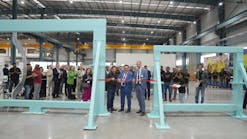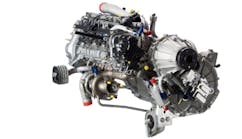MSG-3
The Intelligent Maintenance
There are two phenomena, which took place simultaneously, that can explain this change. The first relates to advances in Reliability and Maintainability science, which resulted in new maintenance philosophy. The second relates to the development of the Maintenance Steering Group (MSG) process. However, one should not forget the technological advances and stricter regulatory design requirements (such as damage tolerant structures, systems safety etc.), which are variables that have an influence on maintenance, but to a lesser degree. This article will address the Reliability and MSG developments only. It will also attempt to clarify the on-going confusion regarding the various maintenance philosophies.
Advances in Reliability and Maintainability
In the early days of aviation, the initial basic maintenance program provided to the operator was developed by the manufacturer. The basic maintenance philosophy utilized was to overhaul everything at a specified time. One underlying assumption in this philosophy was an intuitive belief that because mechanical parts wear out, the reliability of any equipment is inversely related to operating age. It therefore followed that the more frequently equipment was overhauled, the better protected it was against the likelihood of failure.
For years to follow, scheduled maintenance was a craft learned through experience and rarely examined analytically. However, over the years it was found that certain types of failures could not be prevented, no matter how intensive were the maintenance activities. This was not because the intervals were not short enough, nor because the teardown inspections were insufficiently thorough. Moreover, findings also showed that contrary to expectations, for many items, the likelihood of failure did not increase with increasing operating age. In fact, the overhauls and teardowns resulted in a reduction in reliability due to high infant mortality associated with after-installation of equipment.
New approach
The Reliability and Maintainability advances that followed took a new approach toward scheduled maintenance both from analytical and practical points of view. The new reliability approach produced studies that had examined age reliability patterns. Studies published in the Reliability Centered Maintenance (Nowlan and Heap, 1978) have concluded that about 89 percent of items cannot benefit in terms of reliability from a limit on operating age (hard time overhaul). Consequently, only about 11 percent might benefit from a limit on operating age. (See Figure 2 on page 55).
As one can see, a well defined wearout region is not uniform in the six curves and only A & B curves show clear wearout characteristics (6 percent of all items).
Although it is generally assumed that the reliability bathtub curve is representative of most items, only 4 percent of items fit into this pattern (curve A). Moreover, most complex items have been shown to have conditional probability curves represented by curves C to F.
Conclusively, these reliability findings indicate that for the majority of aircraft equipment a hard-time overhaul is an ineffective maintenance practice. Notably, the overhaul practice is extremely expensive and in fact, reduces the reliability of the equipment.
On-condition maintenance
These findings have led to a new maintenance philosophy. Instead of limiting the life of the equipment, the new approach was directed toward detecting the potential failures through scheduled inspection. This new concept became commonly termed as On-condition Maintenance.
During the late 1950s and early 1960s, attempts were made to organize what had been learned from the various reliability programs and to develop a logical and generally applicable approach to the design of preventive maintenance programs. That new approach generated a technique that followed a given decision diagram. Further refinements of this technique were embodied in a handbook on maintenance evaluation and program development. This document became known as the MSG-1.
The MSG-1 development set new ground rules for the development of scheduled maintenance programs, a process commonly known as the Maintenance Steering Group (MSG), and its later derivatives, MSG-2, and MSG-3. Figure 3, on page 56 provides a historical layout of the MSG development.
Each new derivative of the MSG improved on its predecessor in terms of ease of analysis and strength of the logic diagnosis. The MSG philosophy also led to a closer association with the MRB (Maintenance Review Board) process. At present, the MSG-3 method and the MRB process are inseparable. The MRB process is clearly defined in AC 121-22A5.
Maintenance Review Board
The Maintenance Review Board was initially associated with a group of regulatory inspectors, each with specialized skills, who were charged with the responsibility of approving the initial maintenance program for new commercial aircraft. Presently, MRB approval is still in the hands of the regulators, but the process is a joint venture between the manufacturer, vendors, operators and regulators. The process entails an Industry Steering Committee (ISC) assembled with representation from manufacturer-vendors, operators and regulatory authorities. An operator chairs the ISC. The ISC delegates the MSG-3 analysis work to the Industry Working Groups (IWGs) that have similar participation to the ISC and are chaired by an operator. Normally, there are five IWGs (Systems, Structures, Avionics-Electrical, Propulsion and Zonal). The working groups analyze the aircraft using the MSG-3 method and the MSG-3 analysis reports are then submitted to the ISC for approval. The end result of this effort is an initial scheduled maintenance program. The initial scheduled maintenance program is submitted by the ISC to the MRB as the draft MRB Report. Upon MRB approval, the MRB Report forms the initial minimum scheduled maintenance requirements. The MRB Report can be used on its own or as part of the Maintenance Planning Document (MPD). It is important to mention that both the ISC and the Working Groups membership consist of a selected elite of the most qualified personnel in terms of knowledge and experience. Participation in the ISC and the IWGs process is recognized as a great privilege. Furthermore, this unique partnership between the Manufacturer-Supplier Operator and Regulator is extremely beneficial to all the parties involved. It improves communication and understanding of each other's needs. It is a reflection of a democratic system where objectives and goals can be achieved in a free and friendly way.
The evolution of MSG-1, 2 & 3 and the advances in reliability science led to the development and recognition of a number of maintenance philosophies. The maintenance philosophies can be looked upon as evolutionary processes in the field of aircraft maintenance, as they relate to the historical development of MSG, reference Figure 2. Hard-Time being the oldest, utilized only to a limited degree in MSG-1 and 2, and Task Oriented being the most recent utilizing MSG-3 and RCM. These maintenance philosophies are listed below with their definitions:
• Hard-Time: Scheduled removal of all units of an item before some specified maximum permissible age limit
• On-Condition: Scheduled inspections, tests, or measurements to determine whether an item is in, and will remain in, a satisfactory condition until the next scheduled inspection, test, or measurement.
• Task Oriented RCM/
MSG-3: A scheduled maintenance program consisting of a set of tasks each of which is generated through RCM/MSG-3 analysis.
The major difference between MSG-3 and its predecessors is in its holistic approach and being task oriented. The holistic approach looks at consequences of failure to a Maintenance Significant Item (MSI). An MSI is normally considered a complete system or subsystem. The analysis is task oriented as it only allows selecting tasks that are applicable and effective for a given failure consequence. MSG-1 and 2, being maintenance processes oriented, explain ÒhowÓ maintenance is applied to individual components. There is no applicability and effectiveness evaluation applied. Each individual component is evaluated separately, resulting in large number of tasks that bring no specific benefit.
In order to understand better the differences between the maintenance philosophies, let's have a closer look at some of them.
Hard-Time vs On-Condition
Hard-Time, being a scheduled removal of all units of an item before some specified maximum permissible age limit, indicates that we are not considering each unit on its own merits (probability of failure) and generalize to assume that all units or items have the same age characteristics that will end with wearout. One may also conclude that since we are not examining the item prior to its removal we have very little data to evaluate the item for escalation or product improvement.
Take an example of a brake assembly. Under the Hard-Time concept, the brake will be removed at a given fixed time interval. No attention is paid to the condition of the brake, whether it is partially worn, fully worn, or damaged beyond repair. Under the On-Condition concept, the brake assembly is designed for On-Condition inspection. The technician will periodically inspect the wear indicator and the general condition of the brake. At a given limit of the wear indicator, the technician will remove the brake from service for restoration. Moreover, if the brake exhibits unexpected problems, a product improvement can be introduced.
Making the transition
The maintenance on engines is a prime example of the general move from Hard-Time to On-Condition. On the early jet engine, accessories and the engine were removed at fixed intervals for overhaul. The move to go On-Condition allowed detection of potential failures, in many cases, before they became functional failures. For example, under the Hard-Time concept at a given fixed-time interval the engine will be removed from service for a complete overhaul. The engine will be taken apart and many of its components will be replaced even though their useful life has not been exhausted yet. Many components could be found damaged beyond repair due to consequential damage of one or two items. Ideally, On-Condition engines are designed to allow internal inspection and modular replacement. Items in the engine such as a turbine or compressor will be inspected either visually or through a borescope. When degradation is found, corrective action will be taken. Older jet engines had minimal provisions for On-Condition maintenance, while modern engines have been specifically designed for On-Condition, by providing ample access and techniques (borescope, X-rays/isotope, etc.) to detect early erosion, cracks, and loose or broken hardware. Nowadays, engine manufacturers proudly advertise their products as being designed (On-Condition Maintenance) to stay on-wing for over 20,000 hours.
In the 1960's, the move from Hard-Time to On-Condition resulted in higher reliability and safety, and above all, tremendous savings to the operators. Additionally, it allowed collection of real data for surveillance and analysis; in order to make refinements and modifications to the maintenance program. Moreover, it allowed determination of the needs for product improvement. It is well known that scheduled maintenance allows us to maintain the inherent reliability of an item, while product improvement provides means for increasing the reliability and safety of an item.
• Lubrication/Servicing Task of an item to maintain satisfactory operation.
• Operational/Visual Check - failure finding task of an item for hidden safety and hidden non-safety consequences only.
• Inspection/Functional Check - inspection of an item to find any potential failures (detect degradation or actual failure). The inspection includes three categories: General Visual Inspection (GVI), Detail Inspection (DI) and Special Detail Inspection (SDI). The functional check compares measured values against an established standard.
• Restoration of an item at or before some specified age limit (may vary from cleaning or replacement of single parts up to a complete overhaul)
• Discard of an item at some specified life limit.
Systems/powerplant maintenance requirements are defined by evaluating MSI's functions for failure consequences in terms of safety, operation or economics. According to the consequences, one of the following tasks can be selected: lubrication/servicing, operational/visual, inspection/functional, restoration, and discard. If the consequence of failure results in a safety condition (route 5 and 8) and no task is applicable, redesign of the given MSI function is mandatory. Figure 4 provides a simplified MSG-3 Systems logic chart.
Structural maintenance requirements are defined by examining each SSI for likelihood of Accidental Damage, Environmental Deterioration and Fatigue Damage.
Each of these three conditions will evaluate a possible inspection task where necessary. If indeed a scheduled maintenance task is required, a threshold and a repeat interval are established. A Structural Analysis logic flow is depicted in Figure 5.
Zonal requirements
Zonal requirements are defined by assessing each of the aircraft's zones for accidental damage, operation environment and access. These assessments are summarized with a rating system, which can be converted to an inspection task interval. Additionally, GVI tasks from other IWGs are transferred for integration into the zonal program.
MSG-3, being intelligent, is not a static method - it is constantly changing and adapting to the emerging technologies and users' needs. Next generation aircraft designers are integrating MSG-3 requirements at the earliest stages or aircraft development. Key engineering designers are members of the IWGs to ensure that MSG-3 requirements are a top priority. The results can be seen in the next generation aircraft: Boeing's 777, Airbus 340, and Bombardier's Global Express and CRJ's high safety, high uptime and low maintenance costs.
ATA's Maintenance Subcommittee is currently modifying MSG-3 to be in line with the latest technology changes. MSG-3's latest revision is scheduled for release in early 2001.
It is also worth mentioning that practices within the corporate and general aviation markets traditionally have lagged, behind the airlines and the military organizations. In fact, the approach is similar to what the airlines had in the 1960's. Two notable exceptions are Bombardier's Challenger and Global Express business jets, which stand apart in their maintenance approach from the rest of the corporate general aviation world. Figure 6 depicts the labor reductions associated with the application of MSG-3 the Challenger and Global Express.
Adopting MSG-3
It is only recently that other corporate aircraft manufacturers decided to follow and use MSG-3 in developing their maintenance programs. To some degree it is due to Bombardier's approach that the rest of corporate and general aviation started to react and adopt MSG-3 as the method for developing a scheduled maintenance program. It is also worth commending the NBAA Maintenance Committee for affirming MSG-3 as the preferred method for developing scheduled maintenance programs.
It would be impractical to conclude this historical and conceptual review of aircraft maintenance programs development without drawing some conclusive remarks regarding MSG-3, remarks that may serve to both inspire others and stimulate further discussion on this subject.
• The evolution of preventive maintenance has taken us from a Hard-Time, low-reliability into a new age of high-reliability, Task-Oriented maintenance.
• MSG-3 analysis enhances safety by providing justified, clear and complete aircraft coverage.
• Enhances design capability by ensuring that safety criticality is maintained. Safety consequence must have a task to detect deterioration or failure, otherwise redesign is mandatory.
• Items that do not exhibit critical failure mode can be now addressed under the Task Oriented approach entirely on economic terms.
• MSG-3 Intelligent maintenance minimizes human factor by its specificity and minimum intervention.
• Specifically targeted Intelligent maintenance (applicable and effective only) reduces operating cost and increases aircraft availability.
• MSG-3 analysis combined with MRB process provides a program the is user-oriented (operator) and acceptable to the authorities and manufacturer.
• MSG-3 combined with the MRB process speeds up program approval and future program changes (escalations, deletions, or addition of tasks).
The key to effective maintenance programs and greater reliability is a continuing close relationship between maintenance organizations (operators), the manufacturer (designers), and the regulators (FAA, JAA, DOT, etc.). The meaning of this relationship is being sympathetic and understanding to each other's problems, goals, and capabilities.











